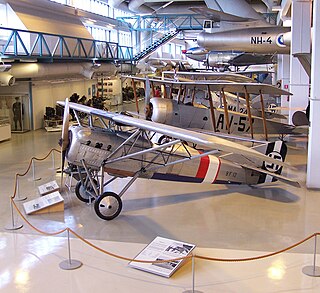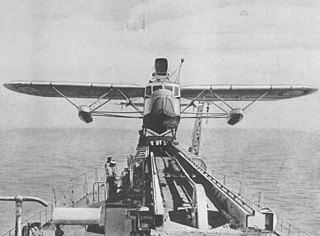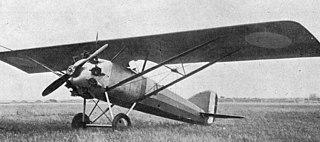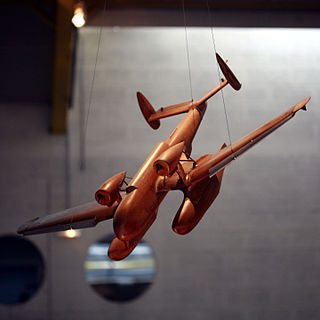Related Research Articles

The Gourdou-Leseurre GL.2 was a French fighter aircraft which made its maiden flight in 1918.

The Supermarine Type 322 was a prototype British carrier-borne torpedo, dive bomber and reconnaissance aircraft of the Second World War. A single-engined monoplane, it was unsuccessful, with only two examples being built. The Fairey Barracuda, built to the same specification, would fill this role.
The Latécoère 611 was a French four-engined maritime reconnaissance flying boat of the Second World War. Although only a single prototype was completed, this served throughout the war, being used by both the Vichy French and Free French navies.

The Potez-CAMS 141 was a French long range reconnaissance flying boat of the late 1930s. Intended to equip the French Navy, only a single prototype was completed before the German invasion of France stopped production. That prototype did, however serve operationally from bases in French North Africa until scrapped in 1943.

The Gourdou-Leseurre GL-812 HY was a 3-seat reconnaissance floatplane, built by Gourdou-Leseurre.

The Loire 130 was a French flying boat that saw service during World War II. It was designed and built by Loire Aviation of St Nazaire.

The Gourdou-Leseurre GL-832 HY was a 1930s French light shipboard reconnaissance floatplane designed and built by Gourdou-Leseurre for the French Navy.

The Loire 210 was a French single-seat catapult-launched fighter seaplane designed and built by Loire Aviation for the French Navy.
The Gourdou-Leseurre Type A, retrospectively named the GL.1, was a prototype fighter aircraft built in France in 1918. It was a conventional parasol-wing monoplane with fixed tailskid undercarriage, with main units connected by a cross-axle. The pilot sat in an open cockpit. Construction was of fabric-covered wood and steel. Initial flight testing revealed performance superior to most contemporary biplane fighters and led to an order of 100 aircraft being placed. However, further tests suggested that the aircraft structure could be considerably lightened, and that the wing needed to be stiffened, leading to a cancellation of the order.

The Gourdou-Leseurre GL.30 was a racing aircraft built in France in 1920 which formed the basis for a highly successful family of fighter aircraft based on the same design.
The Gourdou-Leseurre GL.50, also known as the Gourdou-Leseurre Type F, was a French fighter prototype of the early 1920s.

The Farman NC.470 was a French twin-engined floatplane designed as a crew trainer for the French Navy. It was used in small numbers for both its intended role as a trainer and as a coastal reconnaissance aircraft at the start of World War II.

The Loire-Nieuport 10 was a 1930s French prototype long-range maritime reconnaissance and combat floatplane produced by Loire-Nieuport, a joint venture between Loire Aviation and Nieuport-Delage. It was an attempt to answer the requirements for the Navy's programme Hydravion éclaireur de combat for a large floatplane capable of acting as a torpedo bomber or reconnaissance aircraft.
The Dewoitine D.750 was a prototype French twin-engined torpedo bomber. It was designed prior to the outbreak of the Second World War to operate from the aircraft carriers of the French Navy, but only a single example was completed, with development ended by France's defeat by Germany in June 1940.

The Bernard H.52 was a French floatplane fighter aircraft of the 1930s. It was a single engine, single-seat monoplane built in the hope of being selected by the French Navy. Two prototypes were built, but no production followed.
The SNCASE SE-400 was a prototype French twin-engined coastal patrol floatplane of the Second World War. A single example was flown, but development was abandoned in May 1940 owing to the German invasion of France.

The Hanriot HD.15 was a French two seat fighter aircraft fitted with a supercharger for good high altitude performance, built in the 1920s. Three were ordered by Japan but lost at sea during delivery.
The Gourdou-Leseurre GL-820 HY family of four-seat single-engined floatplanes were designed and built in France during the latter half of the 1930s by Gourdou-Leseurre. The GL-820 HY and GL-821 HY 02 were shipborne reconnaissance / observation aircraft, while the sole GL-821 HY was built as a torpedo carrier.
The Kawanishi E13K, company designation AM-19, was a Japanese 1930s three-seat reconnaissance floatplane.
The SNCAC NC-420 was a French observation flying boat built by SNCAC in the 1940s. It was intended to operate from the ships of the French Navy, but although a single prototype was completed, it never flew.
References
- ↑ Green 1962, pp. 25, 27.
- 1 2 3 Bousquet 1996, p. 12.
- 1 2 3 4 5 6 Green 1962, p. 27.
- 1 2 3 4 5 6 7 8 9 Bruner 1975, p. 5.
- ↑ Bousquet 1996, pp. 12, 14.
- ↑ Bruner 1975, p. 3.
- 1 2 3 4 5 Green 1962, p. 28.
- ↑ Bruner 1975, p. 4.
- Bousquet, Gérard (April 1996). "L'hydravion NC 420: Il a peu flotté, mais beaucoup roulé...". Le Fana de l'Aviation (in French). No. 317. pp. 12–19.
- Bruner, Georges (May 1975). "Les Belles Bêtes du Temps Passé: Un hydravion anti-sous-marin à grand écart de vitesse...Gourdou G120". L'Album du fanatique de l'Aviation (in French). No. 64. pp. 3–5.
- Green, William (1962). War Planes of the Second World War: Volume Six: Floatplanes. London: Macdonald & Co.